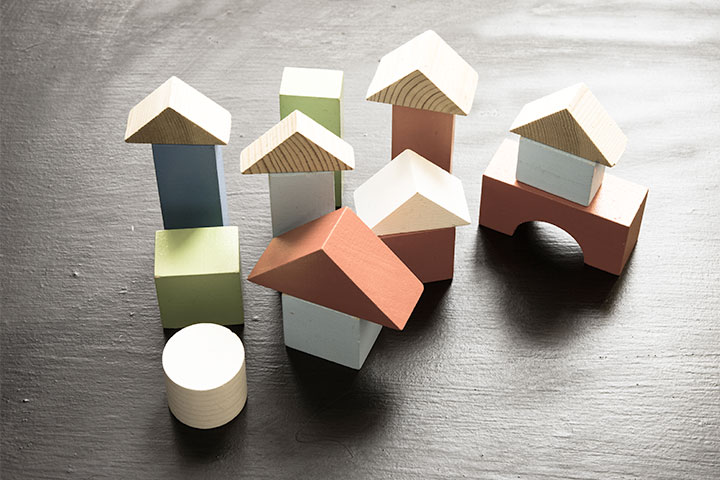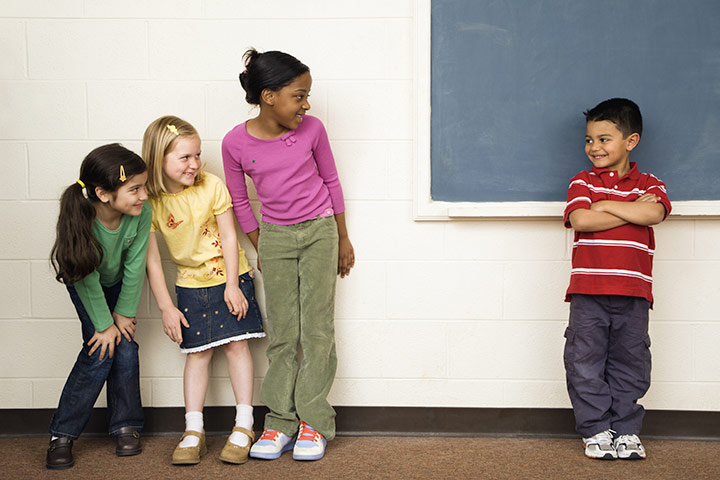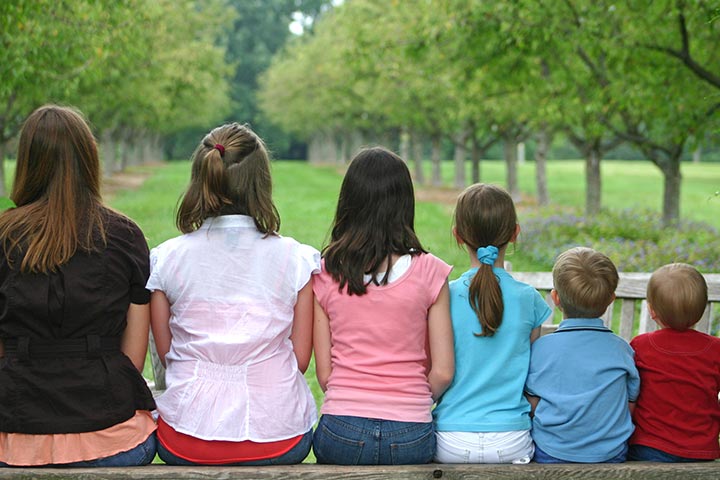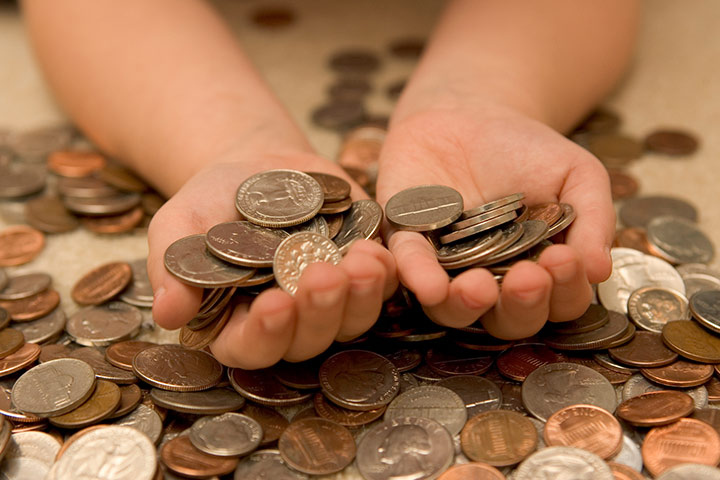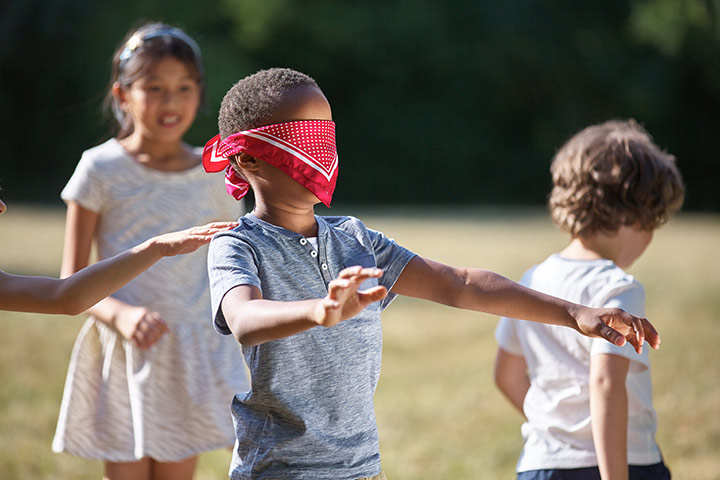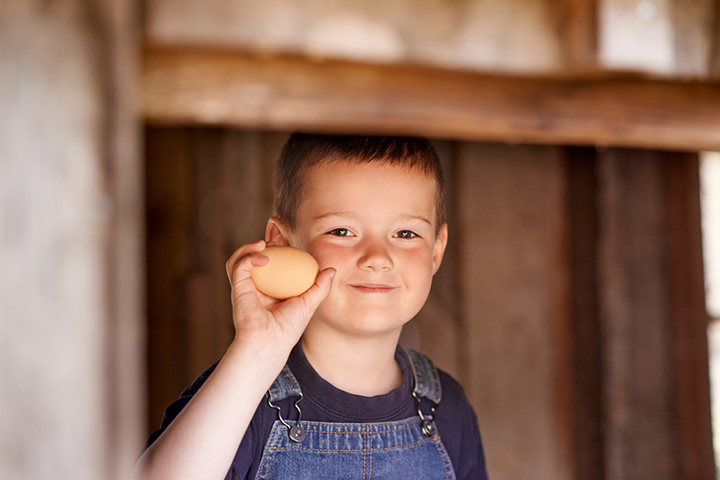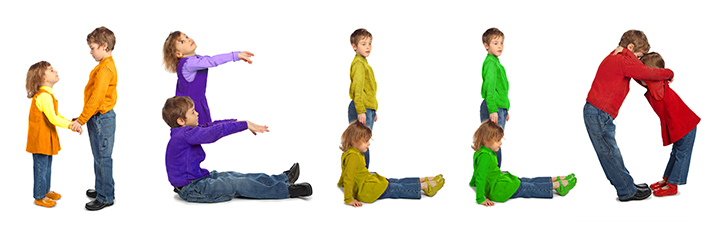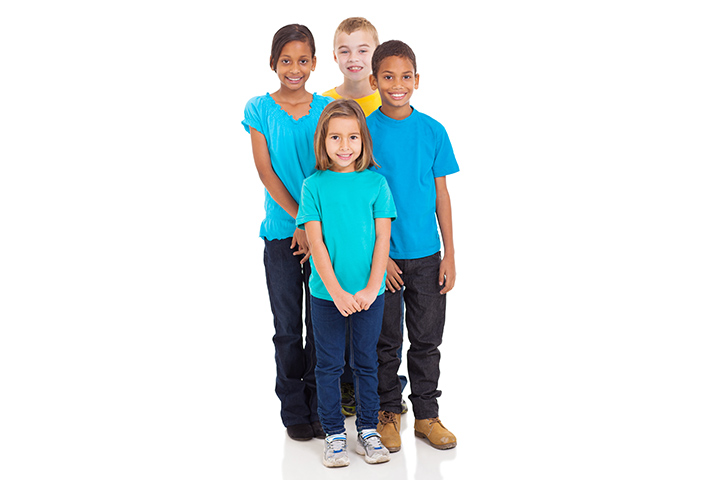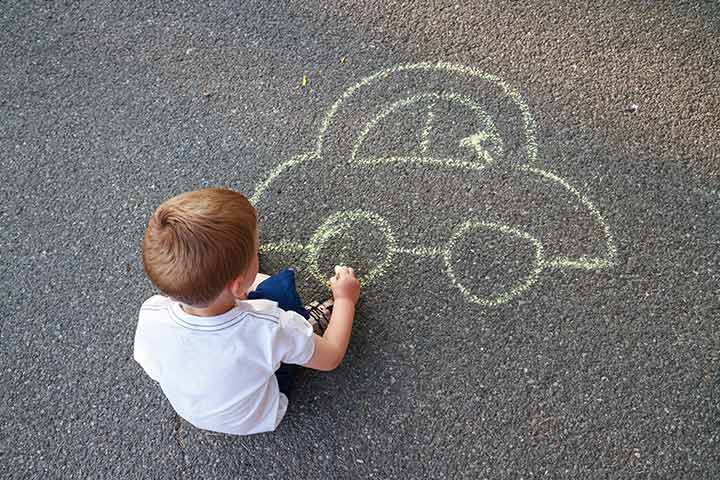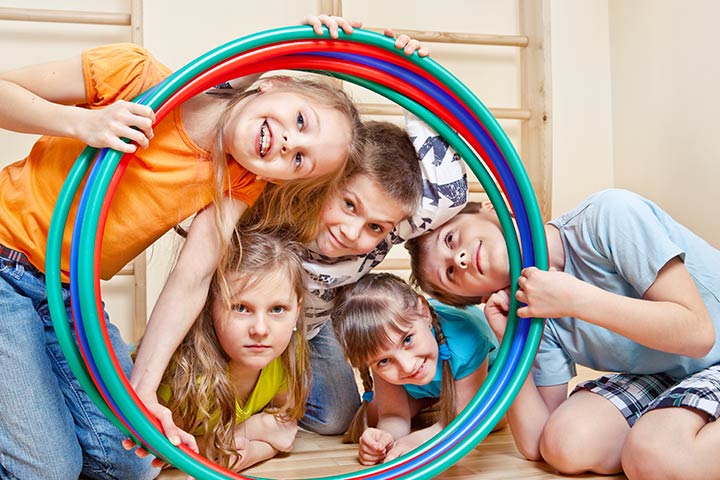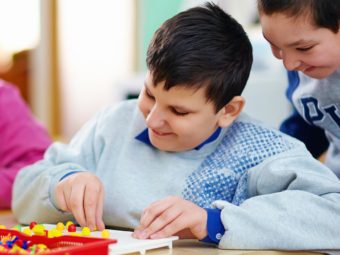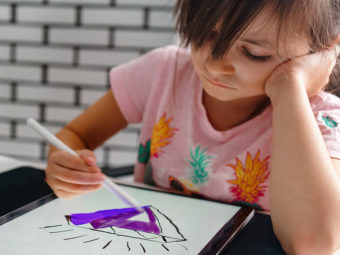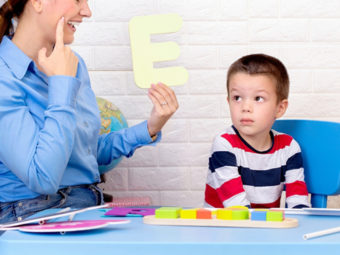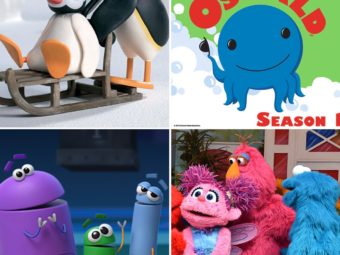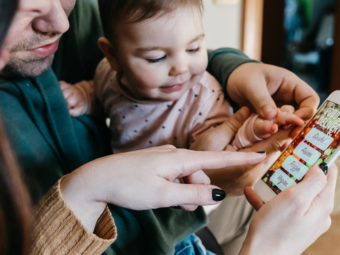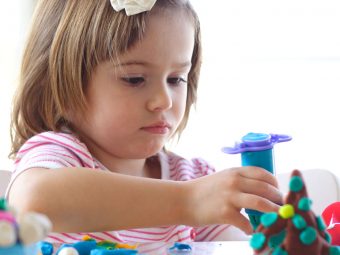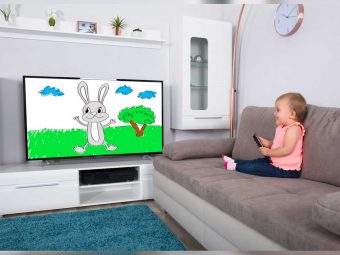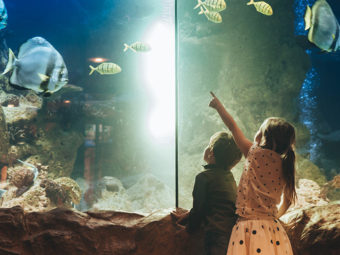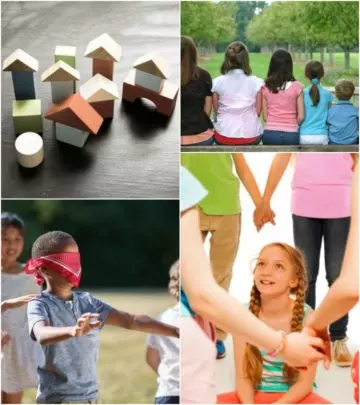
Image: MomJunction Design Team
Mattie J T Stepanek once said that unity is strength…when there is teamwork and collaboration, wonderful things can be achieved. Team building activities for kids are known to teach them life skills that will have a lasting impact in the long run. Whether it is a football game or an orchestra, things can go wrong if the participants are not in sync. When you are teaching team building games, it means you are teaching your child how to succeed as a team. A study reveals that teamwork is a core skill needed for succeeding in the classroom and workplace (1). Here are some team building activities that children can try out at home or at school to keep them engaged during the vacation.
22 Team Building Activities For Kids
Team building activities are good to work for the little ones’ gray cells. They encourage children to find ways to work with each other to achieve a common goal (2). Teamwork helps kids communicate with others, increases their social skills and self-confidence, and helps them develop into happier adults. Whether at home or school, children should learn to be a part of a team of different people. There are several activities that you can use to teach kids about teamwork. We bring you our list of effective team building games and exercises for kids.
Let’s start with fun games.
Fun Team Building Games For Kids
Games are fun. One of the most effective ways to teach your child something is through play (3). This is our list of fun team games for kids they would love to play.
1. Picture Pieces
Picture Pieces combines the fun of drawing and working together as a team. This puzzle solving game is best played indoors.
How it helps:
Teaches kids how ‘departmental working’ and how important teamwork is to achieve the desired result.
Materials:
- A popular cartoon strip or an image that the children can reproduce on paper. The complexity of the diagram should depend on the age-group of the kids.
- Pencils
- Paper
Number of participants: Six to eight
Time required: 30 minutes
Instructions:
- Cut the picture you have selected into six or eight equal squares. Cut the image in such a way that when you join the pieces, the entire picture is in place.
- Give each child a picture and ask him or her to reproduce a copy of the image.
- After 20 minutes, ask the children to bring their drawings together and join them to see if they are able to recreate the picture.
- They can make changes to their work if needed, for a final reproduction as accurate as the original one.
Tips to the facilitator
Give the children papers with squares of the same sizes to draw on each. Ask the children to draw the piece of their puzzle within the box. This will ensure that the images are consistent in size.
2. Sneak A Peek
This game is about memory and recreation of something as a team and it is best played indoors.
How it helps:
The game focuses on communication between team members. It also teaches them to be open to other people’s perception.
Materials:
- Building blocks – you will need as many sets as the number of teams
- Space for kids to work
Number of participants: Three or four teams of four kids each
Time required: 15 minutes
Instructions:
- Create a structure using building blocks, without the kids seeing it – you can do it in another room and bring it to the kids.
- Give each team one set of blocks. Show the structure you have created.
- One person from each team comes and takes a peek at the structure – they have ten seconds to look at it and memorize it.
- The team member will have to explain the structure to the others so that they can recreate it.
- If they don’t get it right, another member from the team can go and take a peek at the structure and go back to helping the others.
Tips to the facilitator:
Create a simple and easy figure to for the kids to understand and replicate by observation and comprehension of design.
 Quick fact
Quick fact3. Classification
Classification is one of the amazing icebreaker games that helps them understand and accept the differences between different people. This is one of the interesting kids’ team building games that can be best played indoors.
How it helps:
This game teaches the kids to classify or make groups of people without any kind of stereotyping, discrimination, or such negative aspects.
Materials: Space for kids to play
Number of participants: 12 or more
Time required: 15 minutes
Instructions:
- Divide the kids into two or three groups.
- Ask the children to tell the others about themselves – their likes, dislikes, dreams, goals, etc.
- Ask them to classify the team into sub-groups based on the information they shared. Groups could be based on the foods, colors, or movies they like, etc.
- By the end of the game – children will know what their friends like and that a team can be made up different kinds of people.
Tips to the facilitator:
Explain the concept of stereotyping – the kids should not use any kind negative judgments or prejudice when creating the sub-groups.
4. Go!
Go is a fun game that teaches children about non-verbal communication, especially eye-contact while working together. It can be played indoors or outdoors.
How it helps:
Go helps children to learn about non-verbal cues and to stay alert.
Materials: Space for the kids to play
Number of participants: 12 to 15
Time required: 15 minutes
Instructions:
- Ask the kids to stand in a circle. Pick a volunteer to be ‘1’, who starts the game.
- ‘1’ makes eye-contact with one player (say 2) in the circle, and indicates them to say ‘go’. Once she receives the command, 1 slowly moves towards the person.
- In the meanwhile, ‘2’ has to make eye-contact with another player (3) who has to say ‘go’ in time to let 2 vacate her spot for 1.
- The players have to continue the game this way, until all of them have changed places.
Tips to the facilitator:
The idea of the game is to time the commands such that each player makes space for the others in time. The best way to explain this game is by demonstration.
5. Group Juggle
This is a fun team challenge game that little kids will enjoy. It can be played by older kids and teens too.
How it helps:
Group challenges help children coordinate better with one another and improve their motor coordination skills as well.
Materials:
- 10-15 Lightweight balls
- This game can be played indoors (room with a high ceiling) or outdoors.
Number of participants: Ten
Time required: 10 minutes
Instructions:
- Divide the kids into two groups of five each.
- The groups stand in a circle, facing each other. Give them the balls and ask them to juggle them in a specific order.
- Start with two juggling balls and introduce more slowly – this makes the activity more challenging for the group.
- The group that can juggle the balls for the longest time, without dropping them, wins.
Tips to the facilitator:
Use lightweight balls or soft balls to prevent injuries to the kids.
6. Tallest Tower
Tallest tower challenges kids to build the tallest possible tower they can with whatever is available around them. This game can be played indoors.
How it helps:
This game encourages the children to get creative in what they use to make their tower the tallest.
Materials:
- Books
- Tins
- Blocks
Anything else that is unbreakable can be used in building the tower.
Number of participants: 15
Time required: 15 minutes
Instructions:
- Divide the children into three groups of five each.
- Give them the needed material for building their tower – they could also use other items in the room, with your permission, to complete their tower.
- On ‘go’, the teams start building a freestanding tower with the material.
- Give them ten minutes to complete the tower.
- The team that finishes the tallest tower first wins.
Tips to the facilitator:
Make sure there is ample space for the tower. Also use unbreakable materials for building the tower.
7. Don’t Wake The Dragon
With the fun element of ‘pretend’, this is an interesting team-building game for kids. This game can be played indoors or outdoors.
How it helps:
Don’t wake the dragon encourages kids to use their imagination to solve an imaginary problem.
Materials: Space to play
Number of participants: 12
Time required: 15 minutes
Instructions:
- The kids have to pretend that they are all residents of a village captured by a dragon, which is currently sleeping.
- The kids can cross the village in order of their height.
- The challenge is that the kids have to arrange themselves according to their heights without talking to each other.
- Once the kids think they are standing in the right order, they have to shout “Boo!” at the dragon and see if it works.
Tips to the facilitator:
The facilitator can be the dragon who decides if the order is right and the children can cross the village.
Be it indoor or outdoor activities, sports games for kids makes them energetic and active all the time.
Team Building Exercises For Kids
Some of these team-building exercises focus on certain skills like communication, cooperation, creative thinking, strategizing, etc.
8. Just Listen
Just Listen is an activity that encourages kids to listen without interrupting or judging. This game is best played indoors.
How it helps:
Encourages listening, comprehending, and accepting another person’s view.
Materials:
- Index cards with different topics
- Space to sit
Number of participants: Ten
Time required: 30 minutes
Instructions:
- Divide the kids into teams of two.
- One kid has to pick a topic blindly and talk about it for two minutes.
- The other child will have to listen and recap what his partner has said at the end. There is no debate, agreement, or criticism in the recap.
- They switch roles and repeat the process.
Tips to the facilitator:
Pick topics that the kids can relate to and talk about without difficulty.
9. Build A Bridge
Build A Bridge is a slightly complex team building activity that is ideal for middle and high school kids.
How it helps:
These creative activities teach kids how to communicate clearly and effectively while enabling them to solve problems in a fun way.
Materials:
- Newspapers
- Masking tape
- Straws or craft sticks
- Plastic pipe or tubes
You could also use a Lego set for the activity.
You should conduct indoor activities with a lot of space where the kids can work.
Number of participants: Eight (even number)
Time required: 45 minutes
Instructions:
- Divide the group into two teams of four each.
- Give each team the material to make the bridge.
- Each team has to make half of the bridge and connect them and complete the design. The trick is to do it without looking at what the other is doing.
- The teams have to rely on their communication skills to try to make identical halves that can be joined.
Tips to the facilitator:
You can ask the teams to choose from simple designs for starters.
10. Zoom
This is a simple activity about developing a story.
How it helps:
This activity enables the kids to use logical skills to complete a short story.
Materials:
- Images that depict a story – you can take comic strips from newspapers or magazines.
- The activity should be conducted indoors, with space where the kids can work.
Number of participants: 10 to 12
Time required: 15 minutes
Instructions:
- Each player gets an image that is a part of a story.
- The kids should not show or discuss the images with the others.
- Once everyone has their own image, they have to come together and put them in the right order to finish the story.
Tips to the facilitator:
Pick a story that does not go beyond 12 or 15 images.
You can also make this a competitive activity.
11. Bus Stop
This is a cool icebreaker that helps kids to know each other better. This team bonding activity can be conducted indoors or outdoors.
How it helps:
It enables the children to express their opinion freely and accept that others do not necessarily share the same views. It also helps build their decision-making skills.
Materials:
- 2 ropes
- Space to play, without obstacles
Number of participants: 10 to 12
Time required: 20 minutes
Instructions:
- The kids will have to stand in between two ropes on either side – these ropes act as the buses.
- The kids have to stand in a line facing the instructor.
- The facilitator will read a word pair, like day/night, book/TV, walk/run, listen/talk, cat/dog, etc.
- Kids have to jump to the bus on the left if they associate most with the first word in the pair, or the right bus if they associate with the second word.
- They have to make a choice of which bus they will board in less than two seconds after the word pair is read aloud.
Tips to the facilitator:
Prepare the setting ahead – place the ropes at an equal distance from where the kids stand.
12. Coin Logo
This is a creative team-building activity for all ages. The activity is best conducted indoors.
How it helps:
The activity encourages brainstorming to come up with a commonly accepted idea or design.
Materials:
- Coins
- Paper
- Pencil
Number of participants: 9 to 12
Time required: 30 minutes
Instructions:
- In a bag, put different types of coins and ask each kid to pick one coin.
- Create groups of three and tell the kids to use their coins as inspiration to come up with ideas for their own coin logo.
- The kids have to design a logo in 20 minutes and then explain what the logo stands for.
Tips to the facilitator:
Ensure you have coins of different denominations, if possible from different countries, for this activity.
13. Night Trail
This is a fun activity with lessons in communication, trust-building, and cooperation. This activity can be conducted indoors or outdoors.
How it helps:
The activity teaches kids to learn to trust and support one another in a team. Cooperation, awareness of risk, and sensory perception are also at play in this activity.
Materials:
- Blindfolds
- Course obstacles – Kid-friendly options like soft tires, cargo nets, blocks for kids
- Soft floor mats
Number of participants: 15
Time required: 30 minutes
Instructions:
- Divide the group into teams of five.
- Blindfold one participant from each group.
- The rest of the team should take turns to instruct their team member to navigate through the obstacle course and reach the finish line.
- The activity can be repeated with each player taking a turn at the course.
Tips to the facilitator:
Prepare the setting beforehand – create a mini obstacle course for the kids inside the room. You can also set it up outdoors, but make sure it is safe for kids.
14. The Great Egg Drop
If you do not mind the kids getting a little messy to learn how to work in teams, this team building activity should be tried. This activity can be conducted indoors or outdoors.
How it helps:
It helps in problem solving – trying different solutions to find the best deal. It encourages kids to think out of the box.
Materials:
Soft, thick fabric, newspapers, cardboard boxes, thermocol, bubble wrap, baskets and other material to build an egg package that can sustain a drop from a height of six feet.
Number of participants: 8 to 16
Time required: 2 hours
Instructions:
- Divide kids into teams of four each and give each team the material to build a package.
- Let them work for 30 minutes to come up with a package that prevents the egg from breaking. In the end, each team will demonstrate the egg drop using the packages they have made and explain how they have succeeded.
Tips to the facilitator:
You may need to have enough eggs for the activity, should the packages fail the first time.
15. Circle Of Silence
This is a cool activity where players get to sharpen their listening skills and strategize to achieve a common goal. This activity can be conducted indoors or outdoors.
How it helps:
The activity encourages creative thinking and interpersonal communication without a lot of noise.
Materials:
- A container – metal or plastic
- Marbles
- Blindfold
- Space to play
Number of participants: Eight to ten
Time required: 30 minutes
Instructions:
- Pick one person from the group to be ‘It’.
- The other players form a circle facing each other and ‘It’ stands in the center.
- The players in the circle should slowly pass a tin box around the circle, without letting the marbles make any noise.
- If the object being passed around makes a noise, and It can point out where the noise is coming from, then he or she points in that direction.
- If ‘It’ gets the answer right, the person who held the tin when it made noise becomes ‘It’.
- Each time, kids can come up with ways to prevent the object from making noise.
- The activity can be played for as long as the kids are having fun.
Tips to the facilitator:
The best materials for this activity would be a tin cup and a few marbles – enough so they can move freely inside the cup.
16. Human Shapes
Human Shapes is a fun and creative exercise that encourages kids to work with each other physically and intellectually.
How it helps:
This activity encourages creative thin and also allows them to use the given space in a smart way.
Materials:
- Soft mats or blanket
- Space for activity
This activity can be conducted indoors or outdoors (on clean grass or surface) but without any obstacles.
Number of participants: 10 to 15
Time required: 20 minutes
Instructions:
This is a small group activity and can be played by the entire group together, or by smaller subsets of the group.
- Ask the participants to spread out in the area.
- Start with individual letters like B, C, T, etc., and ask the participants to form them using their bodies. Two or more kids can come together to form one letter if needed.
- Then, the instructor gives the team a word – it should be at least six letters long.
- Ask the participants to quickly form letters of the word using their bodies. They can try forming the letters by standing or they can lie down on the ground – it is up to them to decide. The objective is for the
- kids to make use of nothing else but their bodies to for the letters of the word.
- This could also be a competition between teams if you have a very large group and area.
Tips to the facilitator:
Kids may lie down on the floor to form shapes that they cannot make while standing. Make sure that the space you choose for the activity is free from dirt and any obstacles that can be harmful to the kids.
17. All Aboard
All Aboard is an activity that will encourage kids to make the most of the space available, without leaving anyone or anything out. This activity is best conducted indoors.
How it helps:
This activity improves the child’s spatial sense, goal setting, leadership, and problem-solving skills.
Materials:
- A piece of chalk and a tarpaulin or rope
- Space
Number of participants: 8 to 15 (depending on the space available)
Time required: 20 minutes
Instructions:
- Make a big circle using a piece of chalk or rope. You could also choose another geometric shape like a square if you want. You can also use the tarpaulin to determine the area of the circle or square.
- Ask the kids to stand inside the circle – luggage and all. The aim is to ensure that everyone is ‘aboard’.
- If the kids are successful, reduce the size of the circle or square and ask them to readjust themselves so that everyone is inside.
- Do this as many times as you can, until the kids cannot fit inside the circle anymore.
Tips to the facilitator:
Make sure that you clearly demark the space that the kids have to occupy.
18. Life Highlights
Life Highlights is an ice breaker activity that can bring the members of a team closer. This activity is best conducted indoors.
How it helps:
This activity enables children to talk about their memories openly, encourages them to put their experience in words, recall specific moments, and analyze.
Materials:
- Space for the activity
Number of participants: 8 to 12
Time required: 30 minutes
Instructions:
- Ask all the participants to close their eyes and think about some of the happy, good memories in their life. It could be something with their family, friends, or anyone in their life. Give them a minute to be ready.
- Ask them to keep their eyes closed and narrow down the highlights of their memories – what they think were the best ones.
- Give each child 30 seconds to talk about one of their best memories and explain why they think it is best.
- The first part of the activity allows the children to think about their life. The second part, which is called the review, lets their friends know them better.
Tips to the facilitator:
This is a simple activity that enables children each other, which is important if they have to work with each other.
19. Dragon’s Den
The activity requires the participants to come up with creative ideas to present to the Dragon – the teacher, parent, or the host. The activity is best conducted indoors, particularly in classrooms.
How it helps:
Dragon’s Den inspires creative thinking, encourages them to come up with the best ideas, and boosts healthy competition as well.
Materials:
- Chart paper
- Pencils
- Markers
- Other presentation material that the kids need
Number of participants: 8 to12
Time required: 1 hour
Instructions:
- Divide the group into teams of three or four.
- The kids should come up with an innovative product that they think can make the world a better place.
- In their presentation, they have to come up with information about
- Name of the product
- What does the product do?
- How will it make the world a better place?
- Name of their company
- Cost of the product
- Once they have the information ad design ready, they can present it at the Dragon’s Den.
Tips to the facilitator:
When conducting this activity for kids, you can use variations for the theme – it can be a drawing or picture or a story or short play that the kids can make and present. The idea here is not to test their business acumen, but to encourage their creativity.
20. Dream Car
Get the kids to collaborate and design their dream car. Every kid may have his or her own ideas of a car, the trick is to see how they can combine them all and come up with a model that everyone is happy with. This activity is best conducted indoors.
How it helps:
Dream car teaches the children about collaboration, adjustments, or compromise – making space for another person’s ideas, creative thinking, and implementation.
Materials:
- Pencils
- Chart Papers
- Markers
Number of participants: 12 to15
Time required: 1 hour
Instructions:
- Divide the group of kids into teams of two or three.
- Give each team a chart paper, a few pencils, and markers. Give them some extra sheets or paper to draw the designs.
- Ask each team to draw a specific part of the car – the trunk, engine, hood, doors, windows, bumper, headlights, seats, etc. Make sure that they draw and then cut out specific parts that can be joined to make a car.
- Ask all the kids to bring the chart paper cut outs to the center of the room and build a car with them.
- The activity can be a lot of fun, or chaotic, depending on how the kids work with each other in the team.
Tips to the facilitator:
Make sure you try this out yourself first – draw specific parts of the car – make cut outs and see if you can design a car out of them. If yes, use the same list of parts to help the kids make their dream car using chart paper cutouts.
21. Hula Hoop Pass
This is a fun activity that kids will enjoy playing. This activity can be conducted indoors or outdoors.
How it helps:
Kids can work on improving their listening, coordinating, strategizing, and implementing skills through this activity.
Materials:
- A hula hoop
- Space for kids to play
Number of participants: Eight to ten
Time required: 30 minutes
Instructions:
- Ask the kids to form a big circle.
- Place the hula hoop on one kid’s arm and then ask him to join hands with the neighbor to close the circle.
- Now, the child with the hula hoop has to find a way pass on the hula hoop to the next person, without letting go of the next person’s hands.
- The goal is to pass the hula hoop around the circle and bring it back to where it started.
Tips to the facilitator:
This is a fun activity that can be replicated for younger or older kids, or even adults.
22. Human knot
This is an excellent bonding activity that can bring all the players together. It demands the participation of all players to make strategized moves. This activity can be played indoors and outdoors.
How it helps:
- This activity can improve children’s listening, coordination, and strategizing skills.
Materials:
- Space for children to play
Number of participants: Minimum six
Time required: 30 minutes
Instructions:
- Ask the children to stand in a circle and raise their arms.
- They must link their right hands with teammates standing across the circle, not the person adjacent to them and repeat the same for the left hands. However, they should not connect
- their both hands with the same person.
- Players aim to untangle the knot by stepping over, under, or through the linked hands.
- One person should run the game and “cut the rope” at two places (that allows two players to drop their hands).
- Players should make the maximum effort to untie the knot.
Frequently Asked Questions
1. What age group is suitable for participating in team-building activities?
There is no specific age group suitable for playing team-building activities. Children can play these games whenever they are old enough to understand their rules.
2. How long should team-building activities for kids last?
The duration of a team-building activity depends upon its complexity and the number of players involved in the game. However, most of these activities last 15 to 30 minutes.
3. What are some safety measures to be taken while conducting team-building activities for kids?
When playing outdoors, children are likely to get hurt. Keep a first-aid kit handy. Also, ensure there are more adults to supervise a large number of children. When playing indoors, ensure there are no sharp objects that can harm the children. Also, there should not be objects that can become choking hazards.
4. Is it important for adults to be involved in team-building activities for kids?
Children may not be able to understand the actual purpose of the activity. The presence of an adult will help them better understand the rules and also the purpose and benefits of the team-building activities.
Team building activities for kids help develop and enhance essential life skills such as creative thinking, listening, leadership skills, and problem-solving as a team. It may also promote compassion and boost self-confidence in kids. Group juggling, building a bridge, and just listening are some of the best team-building activities for children. These activities promote interpersonal skills and help children socialize with peers and accept differing opinions. As a result, children learn from each other and understand how to function as a team to achieve goals.
Key Pointers
- Keep the materials, such as an A4 sheet, pencil, eraser, sharpener, stencil, and ruler, handy for your convenience.
- Start with the most basic and easy design first. Once your child has mastered the easy drawings, move on to the complicated designs.
- Before adding new specifications to the car, practice drawing them separately.
Infographic: Team Building Activities For Children
Besides enhancing their self-esteem, social interactions, and coordination skills, group activities aid children learn about the importance of partnership and togetherness. Here is an infographic documenting interesting and engaging team-building activities for children to have fun and bond with their peers. Illustration: Momjunction Design Team
Check out this video to learn how to bring your kids together with fun team-building games and activities! Get creative and have a blast with your kids while teaching them important skills.
References
- Research Link/Student Teamwork ASCD.
https://www.ascd.org/el/articles/-student-teamwork - 22 fun team building games and activities for kids UNICEF Kid Power.
https://unicefkidpower.org/fun-team-building-activities-for-kids/ - Learning through play UNICEF.
https://www.unicef.org/sites/default/files/2018-12/UNICEF-Lego-Foundation-Learning-through-Play.pdf






